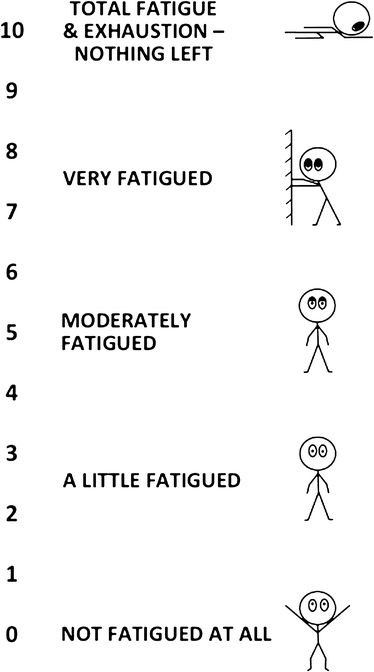There are many tools available for measuring the level of fatigue in a person, from biological assessments to simple questionnaires. Many of these have been developed for patients with conditions such as chronic fatigue. The rating-of-fatigue (ROF) scale that is described here allows you to easily rate how fatigued someone is feeling, in an exercise context. It follows a similar and familiar format to the Ratings of Perceived Exertion (RPE) scales.
 exhaustion
exhaustionFatigue Scale
The ROF scale consists of 11 numerical points that range from 0 to 10. There are also five descriptors and five diagrams to help the person understand the scale and make a rating.
Here are the instructions and the corresponding chart that should be presented to the person who will be rating their fatigue. (from Micklewright et al. 2017)
Instructions
Here are the verbal instructions that should be given to the participant.
- Please familiarize yourself with the scale by looking closely at the ROF scale now. You will notice that the ROF scale consists of 11 numerical points that range from 0 to 10. There are also five descriptors and five diagrams that are intended to help you understand the scale and make your rating.
- When you are presented with the ROF scale please carefully inspect the scale before giving a numerical response from 0 to 10. Always try to respond as honestly as possible giving a rating that best reflects how fatigued you feel at the time.
- Try not to hesitate too much and make sure you only give ONE number as a response. For example, avoid responding by giving two numbers such as 'three or four'.
- Now please read the following examples of what some of the ROF ratings mean:
A response of 0 would indicate that you do not feel at all fatigued. An example of this might be soon after you wake up in the morning after having a good night's sleep. Now try to think of a similar occasion in your past where you have experienced the lowest feelings of fatigue and use this as your reference.
A response of 10 would indicate that you feel totally fatigued and exhausted. An example of this might be not being able to stay awake, perhaps late at night but equally could include situations such as sprinting until you can no longer physically continue. Again try to think of a similar example that you have actually experienced in the past.
The Chart

References
- Al Salman, A., St Clair Gibson, A., Micklewright, D. (2013) The rating of fatigue scale (ROF). Medicine & Science in Sports & Exercise 45(5) Supp 1, 282. ISSN 1530-0315 (conference proceedings)
- Micklewright, D., St Clair Gibson, A., Gladwell, V., Al Salman, A. (2017) Development and Validity of the Rating-of-Fatigue Scale. Sports Med 47: 2375.
Related Pages
- Food and Fatigue — there are many alternative food and exercise strategies that can help to combat fatigue.
- Measurements in Sports Medicine
- RPE: Ratings of Perceived Exertion — there are many versions of this scale
- Resistance Training RPE — a subjective tool combining RPE and RIR, for determining resistance training intensity levels.
- Reps in Reserve (RIR) — how many more strength lifts can you do?
- About the Likert Scale
- More health tests
- Health Tests for Athletes


 Current Events
Current Events